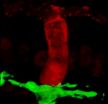(Press-News.org) It can be difficult for someone outside of a specialist field to identify subject experts and the ever increasing amount of available data can be bewildering. New research, published in BioMed Central's open access journal, Journal of Biomedical Semantics, describes a method of social network analysis, similar to finding friends on Facebook, able to sift through scientific literature and news articles to identify opinion leaders and media experts.
Pharmaceutical companies and public health programs rely on opinion leaders to clarify and condense research into a format understandable by the general public and employees. While there are already computer programs which are able to link scientists and medical doctors to their areas of knowledge, this is the first system that is able to identify the opinion leaders from these subject lists.
A team from Lnx Research developed an extraction engine, which used text mining technology, to produce a network of subject experts, and find people, organisations and locations associated with a specific heath topic from research articles. The three sets of results from the search were combined, and, using simple rules, people with the most 'hits' who were most likely to be the opinion leaders were identified. Social network analysis was then used to generate a ranked web of linked experts, based on the number of times they were mentioned together in news articles.
The team tested their program, using the topic 'obesity', and generated a network of over 16,000 experts with 100,000 links between them. The people at the heart of the network, with the most connections, tended to be the subject experts. In about an hour this 'find a friend' system found experts on obesity with an accuracy of about 90%.
Dr Siddhartha Jonnalagadda who led this research explained, "This amount of data would be impossible to sort through without the help of a computer. However when we analysed the results from the program we found that the top twenty obesity experts had all contributed significantly to the advancement of science in the literature and in the news, many having won awards for their work."
Dr Jonnalagadda continued, "We were also able to identify a group of people who, although they were not publishing scientists, were still experts, most likely involved in public education or in science reporting."
So although the system was designed with the aim of finding scientific experts it was also able to find celebrities, and people with a high media profile, who support a particular cause. This information would be invaluable to scientists, students and people wanting to get straight to the heart of a subject.
###
Notes to Editors
1. Discovering opinion leaders for medical topics using news articles
Siddhartha Jonnalagadda, Ryan Peeler and Philip Topham
Journal of Biomedical Semantics (in press)
Please name the journal in any story you write. If you are writing for the web, please link to the article. All articles are available free of charge, according to BioMed Central's open access policy.
Article citation and URL available on request on the day of publication.
2. Journal of Biomedical Semantics is an open access, peer-reviewed journal that considers articles which addresses issues of semantic enrichment and semantic processing in the biomedical domain. This includes infrastructure for biomedical semantics: and semantic mining, annotation, and analysis.
3. BioMed Central (http://www.biomedcentral.com/) is an STM (Science, Technology and Medicine) publisher which has pioneered the open access publishing model. All peer-reviewed research articles published by BioMed Central are made immediately and freely accessible online, and are licensed to allow redistribution and reuse. BioMed Central is part of Springer Science+Business Media, a leading global publisher in the STM sector.
END
New York, NY (March 14, 2012) — Columbia University Medical Center (CUMC) scientists have developed a way to recreate an individual's immune system in a mouse. The "personalized immune mouse" offers researchers an unprecedented tool for individualized analysis of abnormalities that contribute to type 1 diabetes and other autoimmune diseases, starting at the onset of disease. The findings were published today in the online edition of Science Translational Medicine.
The mouse model could also have clinical applications, such as predicting how a particular patient might ...
CLEVELAND -- A catheter procedure that closes a hole in patients' hearts was no more effective than medical therapy in preventing recurrent strokes, according to a new study published in the March 15 issue of the New England Journal of Medicine.
In the CLOSURE I trial, clinical researchers compared a catheter procedure plus medical therapy with medications alone to prevent new strokes or transient ischemic attacks (TIAs) in patients between 18 and 60 years old with an unexplained ("cryptogenic") stroke or TIA and a patent foremen ovale (PFO) – a hole between the heart's ...
VIDEO:
Using two-photon imaging, the researchers were able to see dendritic cells, shown in green, in the intestine of a living mouse.
Click here for more information.
With every meal, immune cells in the intestine stand like sentries at a citadel, turning away harmful bacteria but allowing vitamins and nutrients to pass.
Now, researchers at Washington University School of Medicine in St. Louis have identified the cells that chaperone food antigens, or proteins, in the ...
Of the $25 billion federal settlement funds for mortgage foreclosure abuses, Wisconsin will receive $140 million. The settlement money is being paid by J.P. Morgan Chase, Bank of America, Wells Fargo & Co, Citigroup and Ally (formerly GMAC), and is intended to help homeowners having difficulty making their mortgage payments and individuals who were the victims of improper foreclosures.
According to Assistant Attorney General Holly Pomraning in a recent TheNorthwestern.com article, Wisconsin's share of the settlement will be divided and distributed as follows:
- ...
Foodborne disease outbreaks caused by imported food appeared to rise in 2009 and 2010, and nearly half of the outbreaks implicated foods imported from areas which previously had not been associated with outbreaks, according to research from the Centers for Disease Control and Prevention, presented today at the International Conference on Emerging Infectious Diseases in Atlanta.
"It's too early to say if the recent numbers represent a trend, but CDC officials are analyzing information from 2011 and will continue to monitor for these outbreaks in the future," said Hannah ...
A team of researchers led by scientists at The Rockefeller University has identified a novel mechanism by which influenza interferes with antiviral host response. The finding, reported in this week's issue of the journal Nature, shows that the immunosuppressive NS1 protein of the influenza A virus hijacks key regulators of antiviral gene function by mimicking a core component of gene regulating machinery. The results they describe have major implications for our understanding of the biology of seasonal influenza virus and its pathogenesis. This research also suggests a ...
There was a lot of excitement a few years ago following the discovery of the DNA origami technique. The approach could be used to build nanoparticles of a given shape and size. However, real applications, such as nano-tweezers, remained out of reach. An international team of researchers led by Professor Tim Liedl of the Ludwig-Maximillians-Universitaet Muenchen and Professor Friedrich Simmel of the Technische Universitaet Muenchen have now succeeded in building nanoparticles using optically active DNA building blocks that can be used to modify light in very specific ways.
Coupling ...
STANFORD, Calif. -- A week ago, you started a new prescription medication for acne. Today, you feel dizzy and short of breath and have difficulty concentrating. Your symptoms are not listed in the package insert as possible side effects of the drug, but why else would you be feeling so odd?
Unfortunately, there's no easy answer. Clinical trials are designed to show that a drug is safe and effective. But even the largest trials can't identify irksome or even dangerous side effects experienced by only a tiny proportion of those people taking the drug. They also aren't designed ...
Menlo Park, Calif. — Researchers from Stanford University and the U.S. Department of Energy's SLAC National Accelerator Laboratory have created the first-ever system of "designer electrons" – exotic variants of ordinary electrons with tunable properties that may ultimately lead to new types of materials and devices.
"The behavior of electrons in materials is at the heart of essentially all of today's technologies," said Hari Manoharan, associate professor of physics at Stanford and a member of SLAC's Stanford Institute for Materials and Energy Sciences, who led the research. ...
Families throughout the nation continue to struggle financially. In fact, the prospect of economic stability continues to look so grim professionals have coined this period of time the Great Recession. Many depend on unemployment benefits to make ends meet during these difficult times, but what happens when they run out?
Now, more and more people are looking to Social Security Disability benefits when their unemployment ends. Whether people were disabled before their unemployment began or became disabled while receiving unemployment, Social Security Disability offers ...


